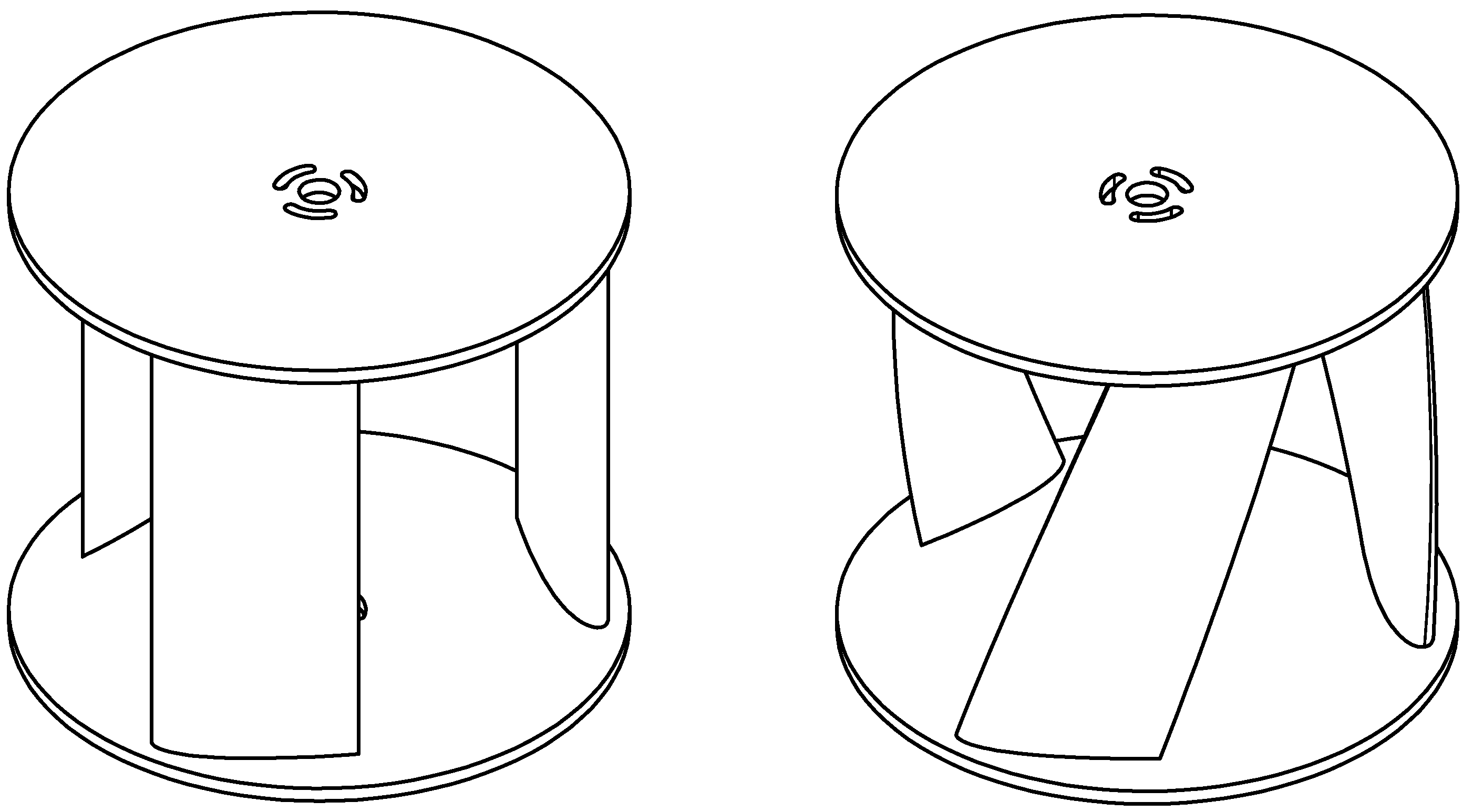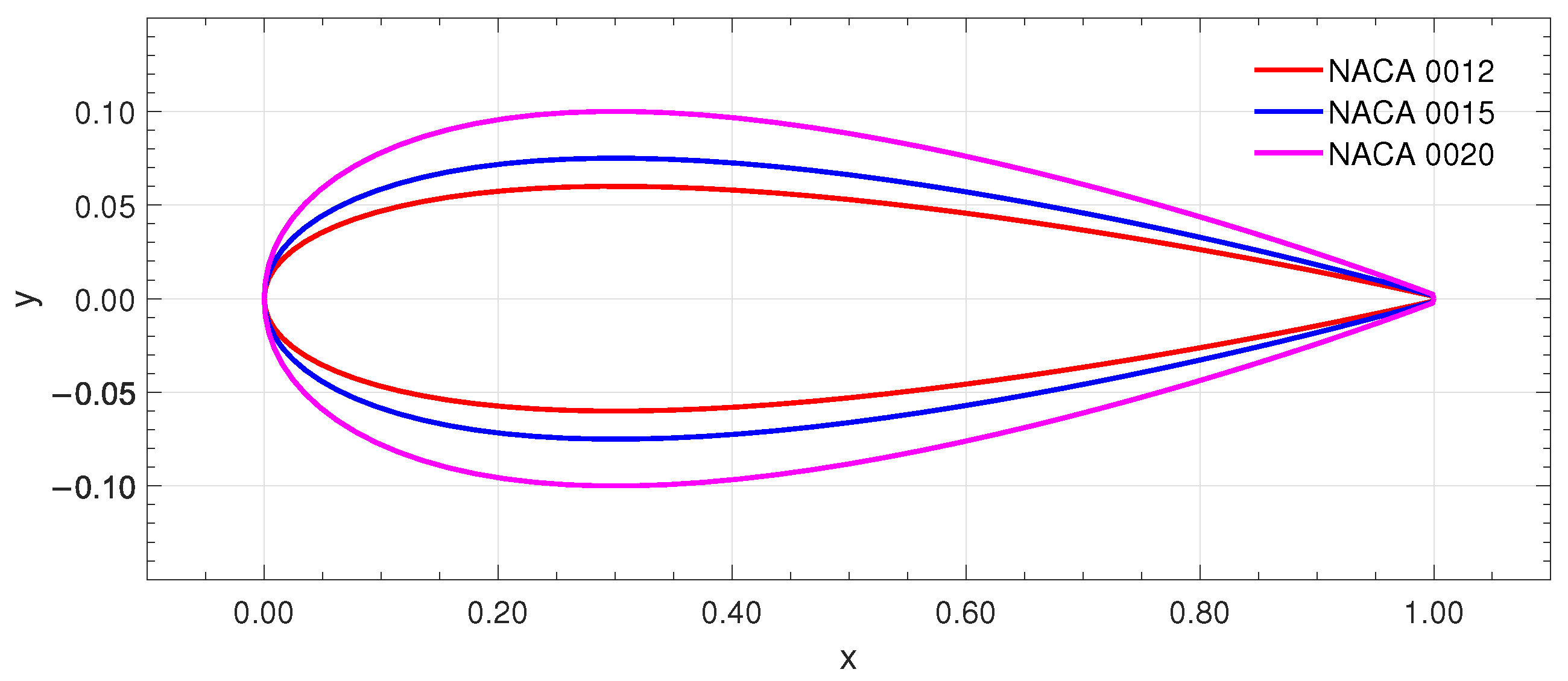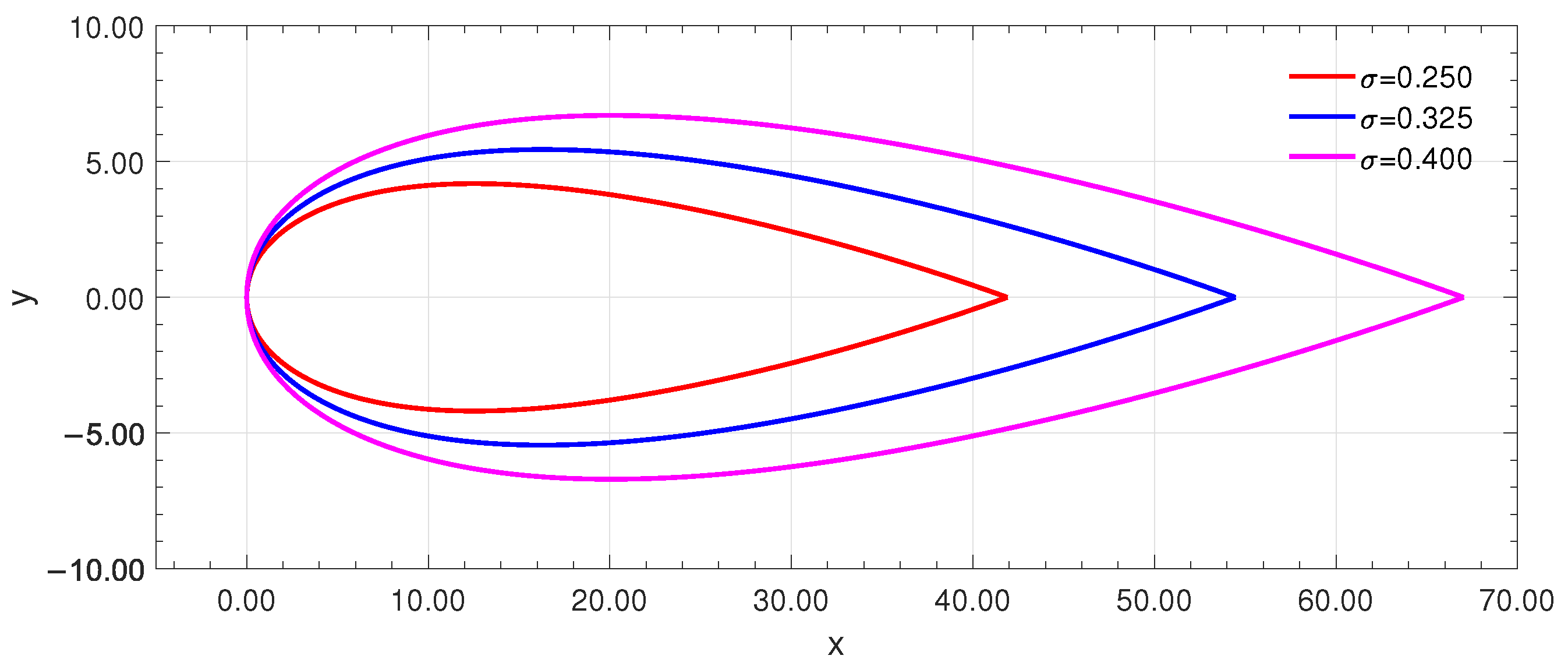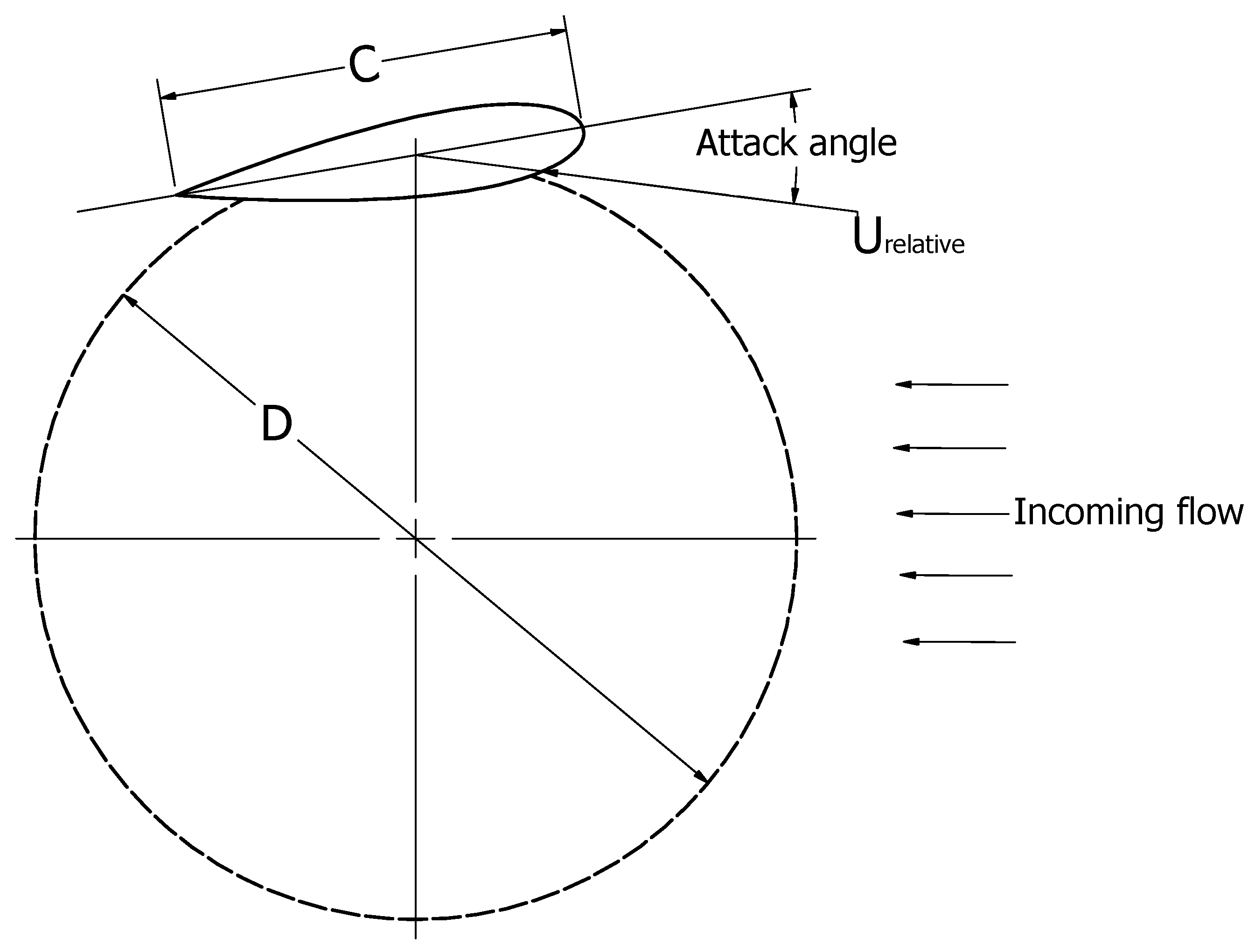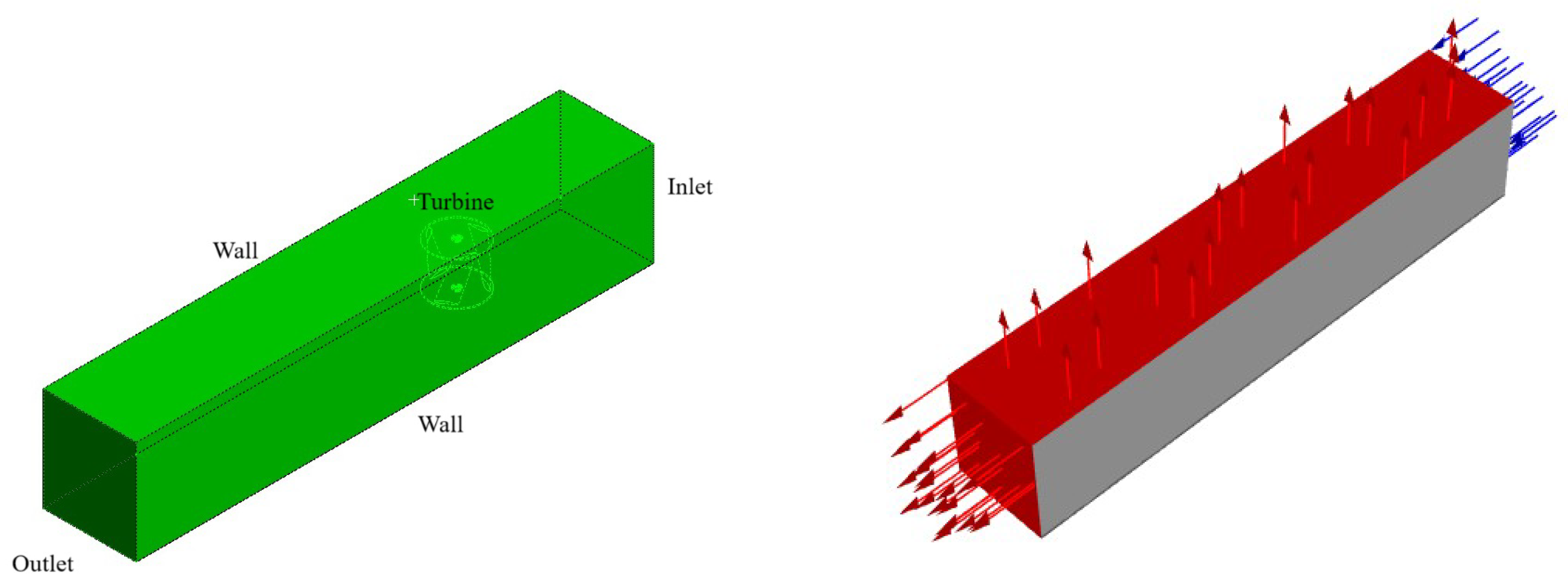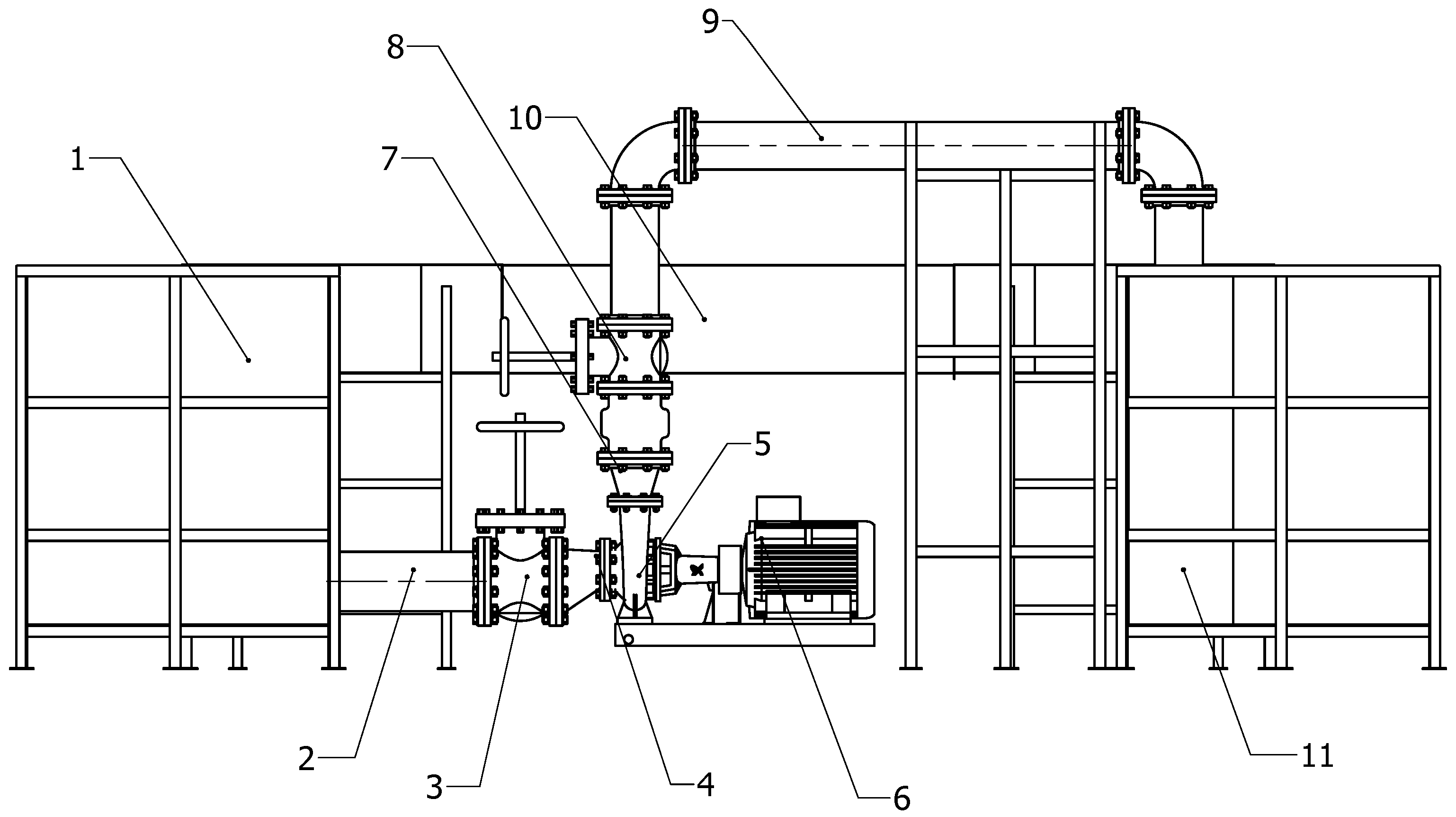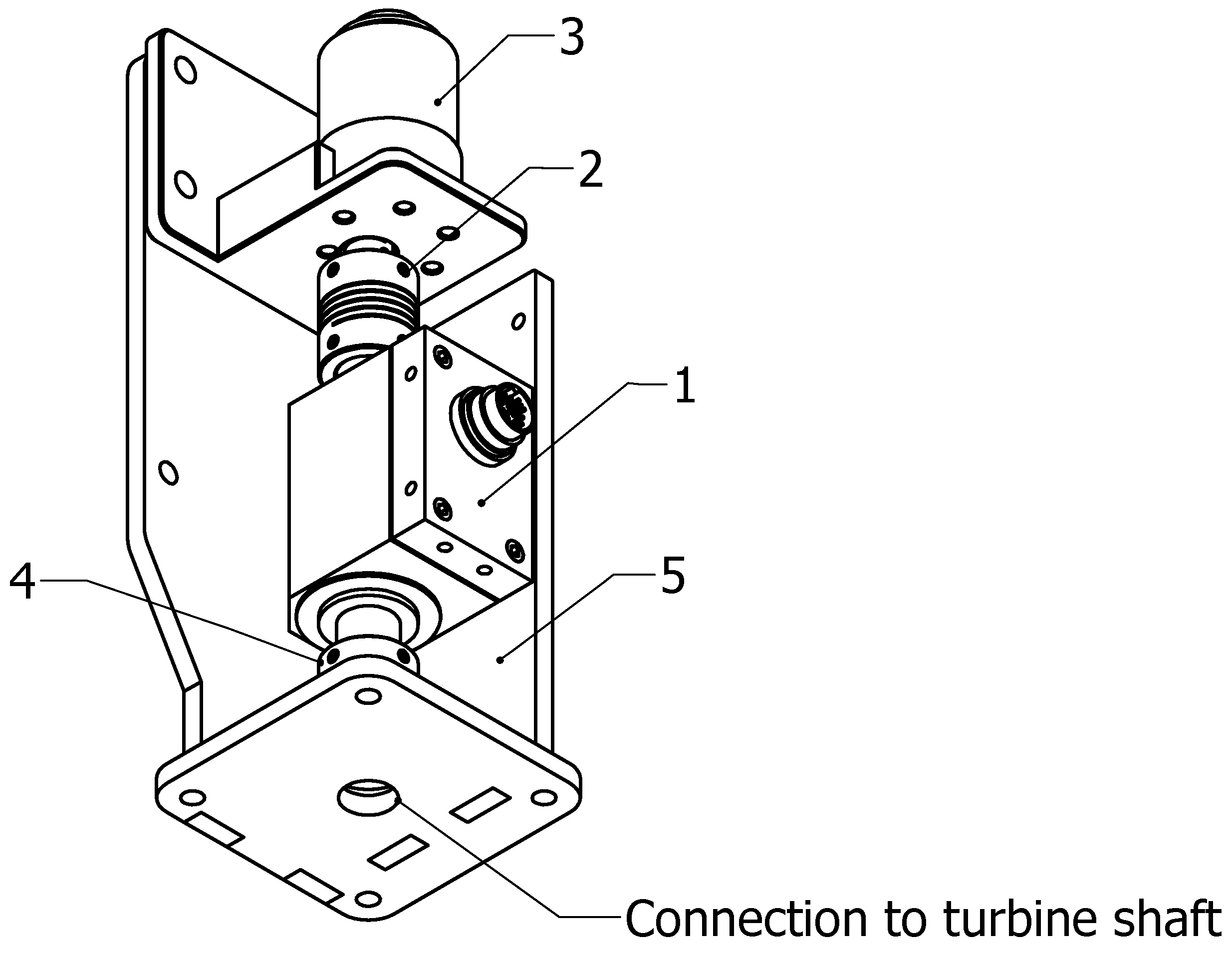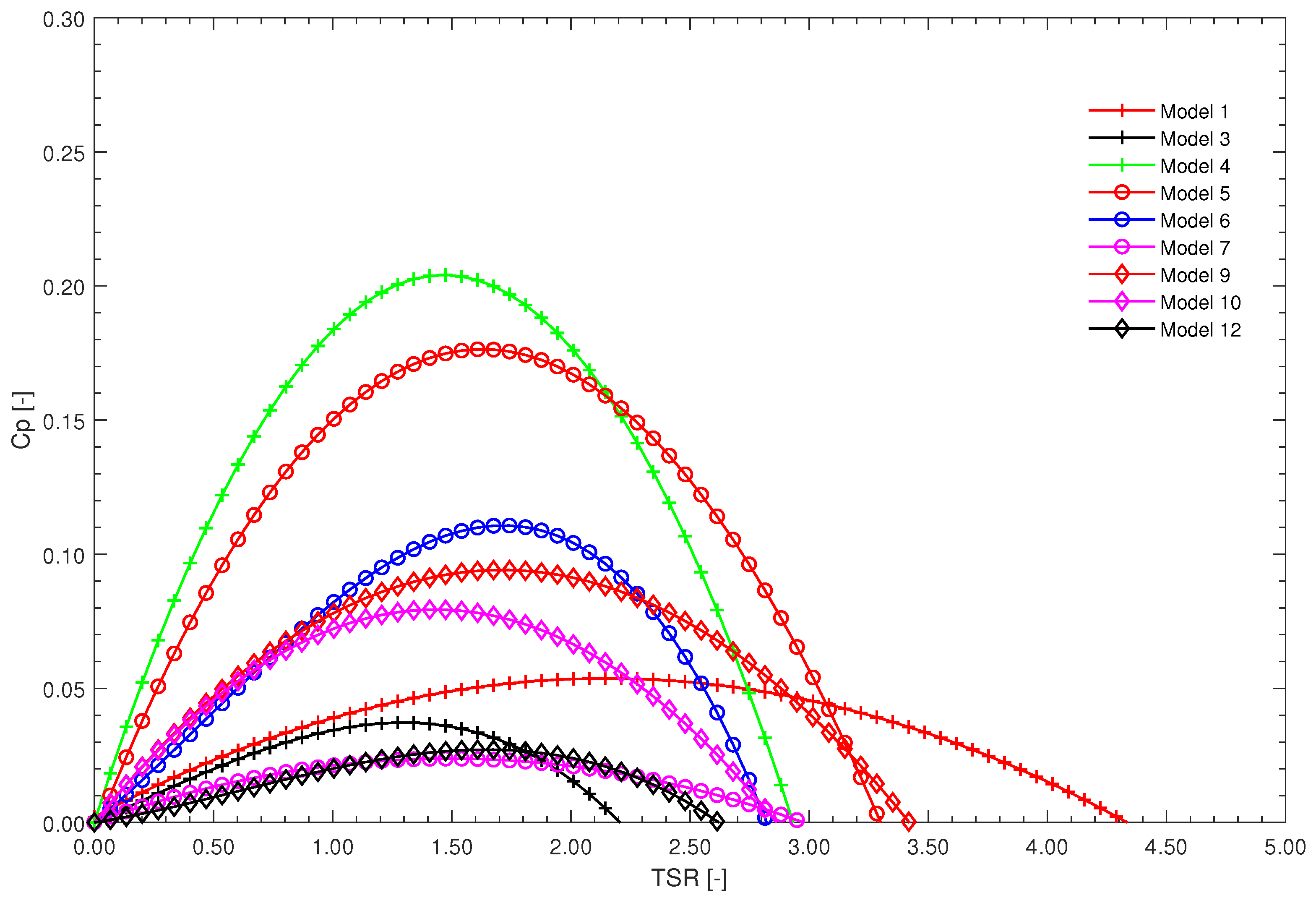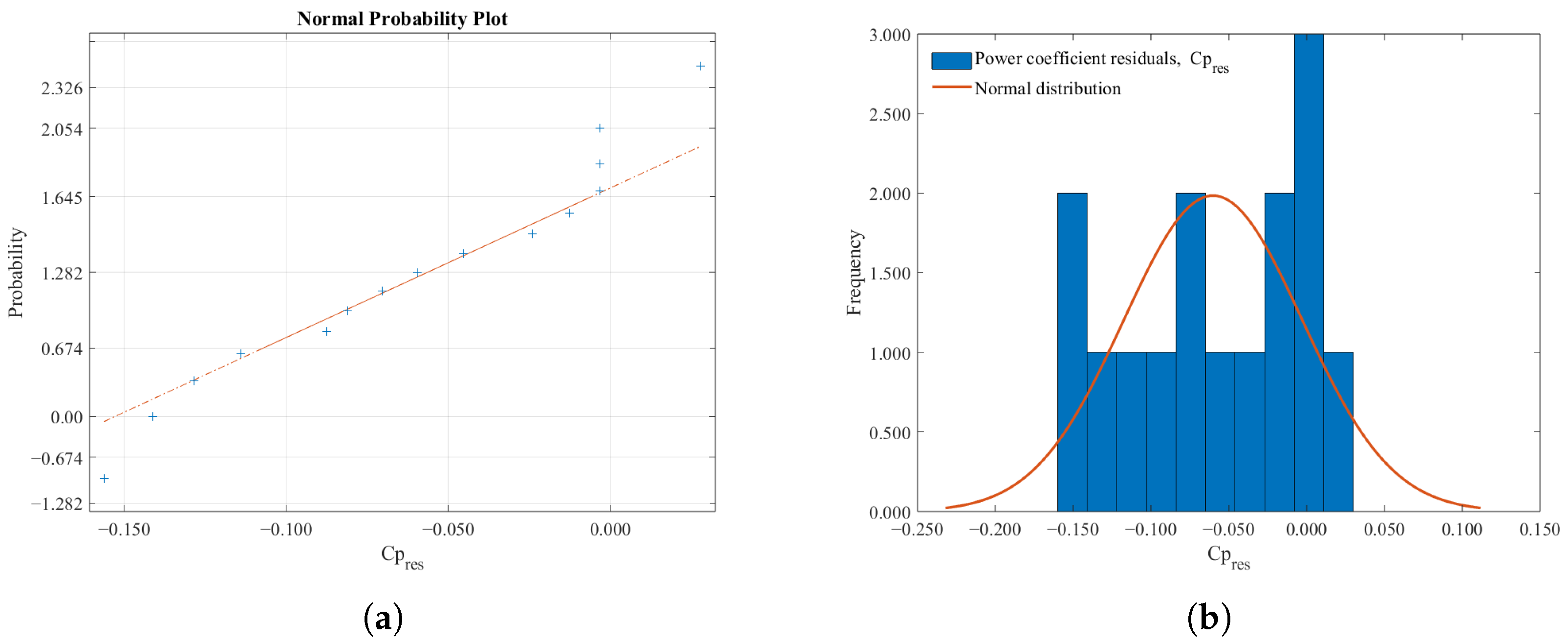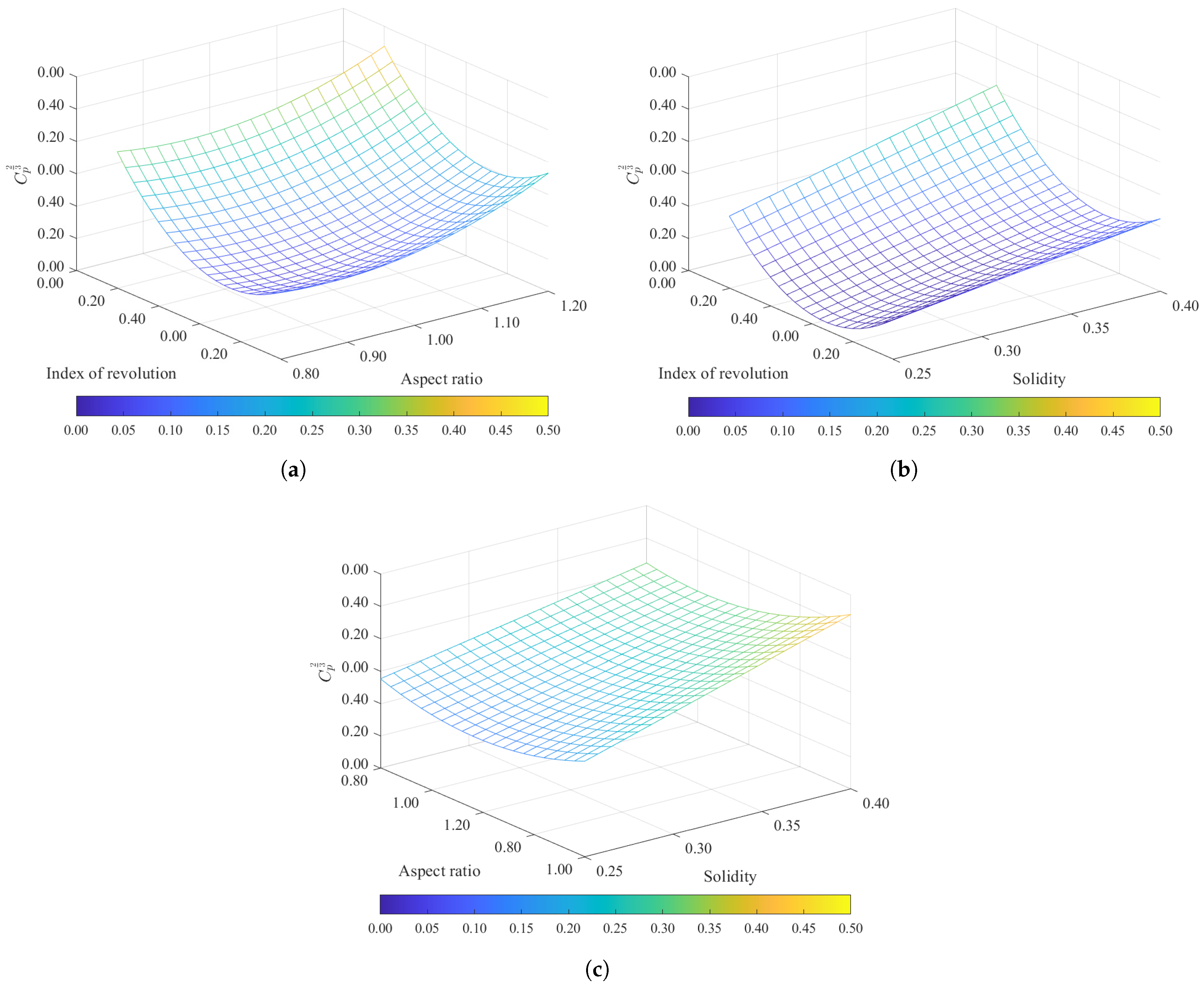1. Introduction
Hydrokinetic energy has materialized as a renewable energy source, particularly for remote or off-grid locations [
1,
2,
3]. Specialized turbines have been developed as a key technology to harness hydrokinetic energy. These turbines can be generally classified into two primary categories: horizontal-axis hydrokinetic turbines (HAHTs) and vertical-axis hydrokinetic turbines (VAHTs) [
4,
5]. Both types of turbines offer numerous environmental advantages, standing out as clean and sustainable technologies for energy generation. Unlike traditional hydropower plants, they do not require the construction of dams or significant alteration of riverbeds, minimizing the impact on aquatic and terrestrial ecosystems. It is important to note that this benefit refers specifically to small-scale systems based on a single turbine, such as the configuration analyzed in this study. In larger-scale deployments—especially those involving multiple turbines or high-blockage arrays—additional infrastructure may be required, potentially increasing environmental and hydraulic impacts [
6,
7]. Additionally, their operation does not produce greenhouse gas emissions or atmospheric pollutants, contributing to climate change mitigation. These turbines are also compatible with the natural flow of rivers, allowing the free movement of aquatic species and reducing habitat fragmentation [
8]. Finally, their ability to harness low-velocity water currents makes them a viable solution for remote or hard-to-access areas, promoting sustainable energy development without compromising natural resources.
Currently, hydrokinetic turbines are in a developing stage, with significant advancements in HAHT and VAHT designs. The existing literature includes a diversity of studies, ranging from computational fluid dynamics (CFD) simulations and experimental testing to field installations and performance evaluations. These studies often focus on improving blade design, enhancing structural durability, and assessing environmental interactions. Despite these efforts, there is a need for further research in areas like the development of adaptive control systems, the integration of hybrid renewable energy systems, and the long-term environmental monitoring of turbine deployments. Among vertical axis designs, Gorlov-type turbines—characterized by their helical-shaped blades—have attracted attention due to their continuous and smooth torque generation. The Gorlov-type turbine emerged as an evolution of the Darrieus turbine, incorporating helical blades that enable a continuous distribution of angles of attack throughout rotation [
9,
10]. This design reduces torque pulsations and facilitates self-starting [
11,
12]. Its geometric configuration provides operational smoothness and mechanical robustness, making it a promising option for both marine and riverine current applications [
13,
14]. Early research focused on validating the basic hydrodynamic principles and demonstrating the feasibility of the Gorlov design, often employing experimental tests and simplified numerical models. Laboratory-scale prototypes were commonly used to assess performance under controlled conditions. In parallel, two-dimensional and three-dimensional CFD simulations provided insight into flow patterns, pressure distributions, and vortex shedding around the helical blades [
15,
16,
17,
18].
Gorlov turbines typically achieve power coefficient values (
) between approximately 0.20 and 0.40, depending on the specific design and flow conditions [
12,
19,
20].
is a dimensionless parameter that represents the efficiency with which a turbine converts the kinetic energy of the fluid into mechanical energy. It is defined as the ratio of the power extracted via the turbine to the total available power in the flow, and it serves as a key performance indicator for hydrokinetic devices [
11,
20].
The optimization of Gorlov-type hydrokinetic turbines presents a complex, multi-variable challenge due to the interdependence of design parameters. To address this, response surface methodology (RSM) was selected as the primary optimization approach in the present study. RSM is a statistical technique that models the relationships between multiple input variables and a response variable—in this case,
—through a series of designed experiments [
21,
22]. This method enables the efficient exploration of the design space and the identification of optimal configurations with a reduced number of simulations or tests.
In the context of hydrokinetic turbine research, RSM has been successfully applied in various studies to optimize rotor geometry, operating conditions, and fluid dynamic performance [
19,
23,
24,
25]. However, to complement the quantitative results provided by RSM and incorporate multi-criteria evaluation, a second method—decision matrix analysis—was also employed in this study. This approach allows for the integration of additional performance indicators beyond
, such as torque stability, structural simplicity, and manufacturability. By assigning weighted criteria to each configuration, the decision matrix enables a more comprehensive and systematic evaluation of design alternatives, supporting the selection of the most balanced and technically viable turbine configuration under practical operating conditions.
Within this context, this research centers on the optimization of Gorlov-type VAHTs. The optimization was performed using the response surface methodology (RSM) and the decision matrix approach, considering solidity (), aspect ratio (), and index of revolution (I) of the helical blade as key parameters. By exploring various geometric configurations, this research aims to identify the design parameters that maximize energy conversion efficiency while minimizing mechanical stresses and operational costs. Through experimental validation, this study seeks to provide a thorough understanding of the effects of geometric modifications on turbine performance.
3. Results and Discussion
Figure 10 presents the results of the comparison between
and
for the turbine models. It is important to note that models 2, 8, 11, 13, 14, and 15 were unable to rotate under the test flow velocity of 0.5 m/s. This outcome highlights the importance of selecting and optimizing turbine geometries to maximize performance under specific operating conditions.
As shown in
Figure 10, all curves exhibit a characteristic trend typical of vertical-axis turbines. Three distinct regions can be identified: I. Growth phase:
initially increases with
, indicating improved energy capture efficiency. II. Peak: Each curve reaches a maximum
at a
, representing the optimal operating point for each turbine model. III. Decline: Beyond this peak,
decreases as the
continues to rise, due to increased losses and flow separation [
79,
80,
81,
82].
Model 4 exhibits the highest
, reaching nearly 0.20 at an optimal
of approximately 1.5. This high efficiency suggests a well-balanced combination of
,
, and
, resulting in effective energy capture. Model 5 shows the second-highest
, around 0.18, with a performance trend like model 4. Its optimal
is slightly higher, at about 1.6. Models 6, 9, 10, and 1 are considered intermediate performers, with maximum
values ranging from 0.05 to 0.12, reached at
between 1.5 and 2.5. This suggests moderate energy conversion efficiency, likely due to geometric configurations that do not fully optimize hydrodynamic performance. The lowest-performing models are 3, 12, and 7, all of which failed to exceed
of 0.05 and reach their peak at relatively higher
between 1.5 and 1.7. Models 2, 8, 11, 13, 14, and 15 recorded a
of zero, as they were unable to rotate under the test conditions. This poor performance indicates potential design issues, such as inadequate
or an unfavorable angle of attack relative to the flow conditions.
Table 3 summarizes the maximum
values achieved with each turbine model.
From the
data collected, a second-order linear regression model was built (Equation (
7)). An analysis of variance (ANOVA) test was also conducted in RStudio 2024.12.0 to evaluate the influence of different factors on the
.
Table 4 contains the
p-values resulting from this analysis, as well as the model coefficients of determination (
and adjusted
). The percentage of variance in the response variable explained by the second-order equation is represented by these coefficients, which ideally should surpass 0.8 to guarantee reliability [
83,
84].
To achieve a statistically significant regression model, it was necessary to transform the response variable (
) by raising it to the power of
. Without this transformation, or when applying more common alternatives such as the square root, cube root, or natural logarithm, the model
p-value did not meet the threshold for statistical significance (
) [
85,
86]. This indicated that the model failed to adequately represent the relationship between the independent variables and
, compromising its validity [
87,
88]. The need for this transformation arises from the fact that the relationship between the variables is not strictly linear in its original form. Transforming
helped stabilize the variance, improve the normality of residuals, and reduce heteroscedasticity, thereby ensuring that the regression model satisfies the fundamental assumptions of statistical analysis [
89,
90]. The specific exponent of
was determined through iterative testing, evaluating which transformation provided the best fit and yielded statistically significant coefficients, thus ensuring the validity and robustness of the final model.
Analyzing the
p-values in
Table 4 at a significance level of 0.05 revealed that the most influential term affecting
is the quadratic term of the index of revolution (
), with a
p-value of 0.000223. The least influential terms in explaining the variation in
are, first, the interaction between the index of revolution and aspect ratio
, followed by the interaction between the index of revolution ratio and solidity
. With a total
p-value of 0.0007995, the model’s statistical significance is confirmed, showing that it accurately describes how the experimental variables relate to
behavior. The residual sum of squares, at 0.00709, implies that the variance not explained is quite low.
The
value of 0.9649 indicates that the model explains 96.49% of the variance in
. The adjusted
of 0.9181 further supports the strength and reliability of the model. The final regression model is presented in Equation (
7).
The
term was excluded from the final regression model, as its
p-value in the ANOVA table exceeded 0.8, indicating that it was not a significant contributor to the model. In addition to the
and
p-value, the model requires conducting a residual analysis, which examines the differences between the observed and predicted
values [
91].
In regression modeling, verifying the normality assumption of residuals is crucial for the validity of the analysis [
92,
93,
94]. This requirement was initially assessed visually by examining the frequency distribution (
Figure 11a), where histogram bars should match the normality line (red). Subsequently, the normal probability plot was inspected (
Figure 11b), with data points expected to closely track the red line, indicating normally distributed residuals. These graphical evaluations were further supported with numerical tests (
Table 5). As all
p-values in the table were above 0.05, the residuals indeed follow a normal distribution.
The independence of residuals, which indicates the absence of autocorrelation, is another fundamental assumption [
95,
96]. The assumption was checked using the Durbin–Watson test, which returned a
p-value of 0.8527. Such a high
p-value confirms that the residuals are independent and randomly distributed. The Breusch–Pagan test, yielding a
p-value of 0.05964, confirmed the homoscedasticity of the residuals, indicating constant variance [
89]. This finding, along with prior normality checks, collectively validates that the regression model satisfies essential assumptions for reliable analysis.
With the model’s validity having been confirmed, the model can now predict the best design, identified as the setup that yields the highest
. The response surfaces showing how factor pairs interact are depicted in
Figure 12.
Figure 13 shows the 2D contour plots of the response surfaces, which clearly illustrate the relationship between
,
I,
, and
in a two-dimensional (2D) plane. These visualizations are particularly useful for identifying optimal regions within the design space, as they facilitate the interpretation of the combined effects of the studied factors. Additionally, the 2D views help reveal potential interactions between variables, providing a more intuitive understanding of how the response values change as a function of the analyzed parameters.
From
Figure 12a, a non-linear behavior of
can be observed, with a maximum point located approximately at an
close to 1.1 and a low
I (around 0.1). As
increases,
rises progressively, suggesting that a higher
is favorable for improving the turbine efficiency under these conditions. The trend of the contour lines also indicates that the
I plays a key role, as
increases at very low values of
I.
Figure 12b, a valley or minimum region of
is identified, which is centered approximately at
and
. In this area,
reaches values close to zero, suggesting an unfavorable combination of parameters. Regarding the effect of
I (from 0.10 to 0.50),
initially decreases and then begins to rise slightly at the extremes. The minimum occurs at intermediate values, indicating a potentially non-linear behavior. As for
,
improves gradually with increasing
, particularly toward the upper right region of the graph (where
and
). This trend suggests that a higher
is beneficial for improving turbine efficiency, especially under conditions of low
I. From
Figure 12c,
is seen to increase with both
and
, though more significantly with
. For
values above 0.35 and
near 1.2,
reaches the highest values. The distribution of the contour lines suggests that
has a less pronounced influence than
in this parameter combination. Based on the previous figures and the regression model expressed in Equation (
7), the optimal configuration corresponds to model 4, with a predicted
of 0.1793. Model 4 features an
I of 0.1, a
of 0.4, and an
of 1.0. This represents the optimal model identified through the RSM.
In the following section, the optimal model was determined using the decision matrix and the evaluation criteria previously outlined.
Figure 14 shows the pressure field on one of the studied models, obtained from the fluid dynamics simulation. In the figure, the red color indicates areas of higher pressure, while the blue color corresponds to regions of lower pressure. These pressure distributions obtained from the CFD analysis are then mapped onto the CAD model to serve as input for a structural analysis within an FSI framework. This process allows for the evaluation of the mechanical response of the turbine components under realistic operating conditions, ensuring that the design can withstand the loads imposed by the fluid flow.
Figure 15 shows the maximum and minimum deformations for model 4, which are caused by the fluid pressure distribution illustrated in
Figure 14. This procedure was repeated for the 15 models analyzed, and the resulting maximum deformations are presented in
Table 6. Since the pressure field varies across each model due to differences in geometry and flow interaction, the resulting deformations also differ accordingly. It is important to note that the deformation displayed in
Figure 15 is scaled to enhance visualization; in fact, the rotor does not deform to the extent shown in the figure. Specifically, the deformation is magnified by a scale factor of
. Additionally,
Table 6 includes the volume of each model.
Table 7 presents the results obtained for the 15 models based on the five criteria defined for the decision matrix: deformation, volume, energy performance (measured with
), ease of manufacturing, and self-starting capability under load. Each model was evaluated using these criteria, and a weighted scoring approach was applied to mine the overall performance of each design. The total score (
) for each model was calculated by multiplying the normalized value of each criterion by its assigned weight and summing the results. This is expressed in Equation (
8) [
97,
98].
where
represents the weight assigned to criterion,
j is the number of model, and
is the normalized value of the model for that criterion. The model with the highest total score is considered the optimal design according to the multi-criteria decision analysis.
Based on
Table 7 and the established evaluation criteria, Turbine 4 emerges as the best overall option, achieving the highest total score of 3.4 out of a possible 5 points. According to criterion 1 (deformation), turbine 4 stands out by receiving the maximum score (5), indicating excellent structural performance with a minimal deformation under fluid pressure. This characteristic is crucial for maintaining mechanical integrity and ensuring long-term durability under operational conditions. For criterion 2 (volume), turbine 4 receives a low score of 1, suggesting it is one of the models with a larger volume. In contrast, turbines 1, 2, 8, and 11 obtain the maximum score (5), indicating more compact and potentially material-efficient designs. Reducing volume can lead to lighter structures and lower material costs, making this an area for potential optimization in turbine 4. Regarding criterion 3 (self-starting capability under load), turbine 4 scores the maximum (5), along with turbines 3 and 10. This result highlights its excellent performance in initiating motion autonomously, even under resistive torque. Such behavior is critical for stand-alone or remote installations where external starting mechanisms are not feasible.
For criterion 4 (energy efficiency or ), turbine 4 receives a score of 2, which is slightly better than most models that scored only 1. While it does not reach the maximum performance level, this still indicates a decent level of energy conversion. Improving this criterion could significantly enhance the overall energy output of the system. Finally, in criterion 5 (ease of manufacturing), turbine 4 achieves the maximum score (5), shared with turbines 3, 5, 6, 7, 9, and 12. This reflects a design that is relatively simple to fabricate, likely to involve fewer components or more accessible manufacturing processes. High manufacturability reduces production time, costs, and complexity, which is beneficial for prototyping and scaling up.
Turbine 4, which is depicted in
Figure 16, stands out for its outstanding performance in criteria 1, 3, and 5. Although there is room for improvement in criterion 2, its overall performance positions it as the best option according to the established evaluation criteria.
